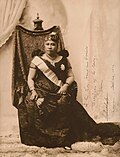Portal:Hawaii
The Hawaii Portal Hawaii (/həˈwaɪ.i/ hə-WY-ee; Hawaiian: Hawaiʻi [həˈvɐjʔi, həˈwɐjʔi]) is an island state of the United States, in the Pacific Ocean about 2,000 miles (3,200 km) southwest of the U.S. mainland. It is the only state not on the North American mainland, the only state that is an archipelago, and the only state in the tropics. Hawaii consists of 137 volcanic islands that comprise almost the entire Hawaiian archipelago (the exception, which is outside the state, is Midway Atoll). Spanning 1,500 miles (2,400 km), the state is physiographically and ethnologically part of the Polynesian subregion of Oceania. Hawaii's ocean coastline is consequently the fourth-longest in the U.S., at about 750 miles (1,210 km). The eight main islands, from northwest to southeast, are Niʻihau, Kauaʻi, Oʻahu, Molokaʻi, Lānaʻi, Kahoʻolawe, Maui, and Hawaiʻi, after which the state is named; the latter is often called the "Big Island" or "Hawaii Island" to avoid confusion with the state or archipelago. The uninhabited Northwestern Hawaiian Islands make up most of the Papahānaumokuākea Marine National Monument, the largest protected area in the U.S. and the fourth-largest in the world. Of the 50 U.S. states, Hawaii is the eighth-smallest in land area and the 11th-least populous; but with 1.4 million residents, it ranks 13th in population density. Two-thirds of Hawaii residents live on O'ahu, home to the state's capital and largest city, Honolulu. Hawaii is among the country's most diverse states, owing to its central location in the Pacific and over two centuries of migration. As one of only six majority-minority states, it has the only Asian American plurality, the largest Buddhist community, and largest proportion of multiracial people in the U.S. Consequently, Hawaii is a unique melting pot of North American and East Asian cultures, in addition to its indigenous Hawaiian heritage. Settled by Polynesians sometime between 1000 and 1200 CE, Hawaii was home to numerous independent chiefdoms. In 1778, British explorer James Cook was the first known non-Polynesian to arrive at the archipelago; early British influence is reflected in the state flag, which bears a Union Jack. An influx of European and American explorers, traders, and whalers soon arrived, leading to the decimation of the once-isolated indigenous community through the introduction of diseases such as syphilis, tuberculosis, smallpox, and measles; the native Hawaiian population declined from between 300,000 and one million to less than 40,000 by 1890. Hawaii became a unified, internationally recognized kingdom in 1810, remaining independent until American and European businessmen overthrew the monarchy in 1893; this led to annexation by the U.S. in 1898. As a strategically valuable U.S. territory, Hawaii was attacked by Japan on December 7, 1941, which brought it global and historical significance, and contributed to America's entry into World War II. Hawaii is the most recent state to join the union, on August 21, 1959. In 1993, the U.S. government formally apologized for its role in the overthrow of Hawaii's government, which had spurred the Hawaiian sovereignty movement and has led to ongoing efforts to obtain redress for the indigenous population. (Full article...) This is a Featured article, which represents some of the best content on English Wikipedia..
 This is a Good article, an article that meets a core set of high editorial standards.
Lilo & Stitch is a 2002 American animated science-fiction comedy-drama film produced by Walt Disney Feature Animation and released by Walt Disney Pictures. It was written and directed by Chris Sanders and Dean DeBlois (in their directorial debuts) and produced by Clark Spencer, based on an original story created by Sanders. It features Daveigh Chase and Sanders as the voices of the title characters and also features the voices of Tia Carrere, David Ogden Stiers, Kevin McDonald, Ving Rhames, Jason Scott Lee, and Kevin Michael Richardson. It was the second of three Disney animated feature films (the first being Mulan and the third, Brother Bear) produced primarily at the Florida animation studio in Disney's Hollywood Studios (named "Disney-MGM Studios" during its production) at Walt Disney World near Orlando, Florida. The film's story revolves around two individuals: an orphaned Hawaiian girl named Lilo Pelekai, who is raised by her older sister, Nani, after their parents' deaths, and the extraterrestrial creature Experiment 626, who is adopted by Lilo as her "dog" and renamed "Stitch". Stitch, who was genetically engineered to cause chaos and destruction, initially uses Lilo to avoid recapture by the intergalactic federation. They develop a close bond through the Hawaiian concept of ʻohana, or extended family, causing Stitch to reconsider his intended destructive purpose in order to keep his newfound family together. (Full article...)Selected Picture - 'Ōlelo (Language) -This section is here to highlight some of the most common words of the Hawaiian Language, ʻŌlelo, that are used in everyday conversation amongst locals.
Hou
New, fresh, again, more State Facts
State Symbols:
Selected article -Kauaʻi (Hawaiian: [kɐwˈwɐʔi]), anglicized as Kauai (English: /ˈkaʊaɪ/ KOW-eye or /kɑːˈwɑː.iː/ kah-WAH-ee), is one of the main Hawaiian Islands. It has an area of 562.3 square miles (1,456.4 km2), making it the fourth-largest of the islands and the 21st-largest island in the United States. Kauaʻi lies 73 miles (117 km) northwest of Oʻahu, across the Kauaʻi Channel. The island's 2020 population was 73,298. (Full article...)Did you know? -
Hawaii News
Wikinews Hawaii portal
Quotes - "The people to whom your fathers told of the living God, and taught to call 'Father,' and whom the sons now seek to despoil and destroy, are crying aloud to Him in their time of trouble; and He will keep His promise, and will listen to the voices of His Hawaiian children lamenting for their homes." — Queen Liliʻuokalani On this day...May 25
Related portalsTopicsCategoriesAssociated WikimediaThe following Wikimedia Foundation sister projects provide more on this subject:
SourcesDiscover Wikipedia using portals |
























